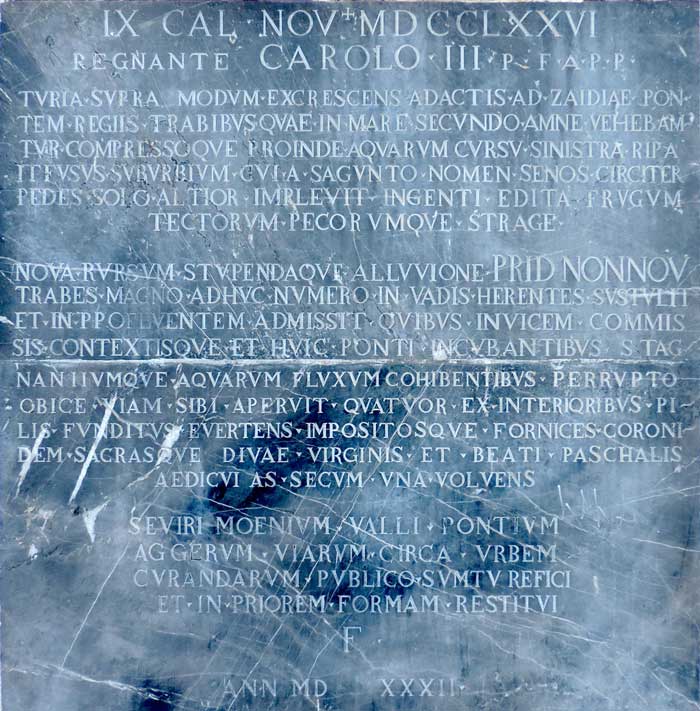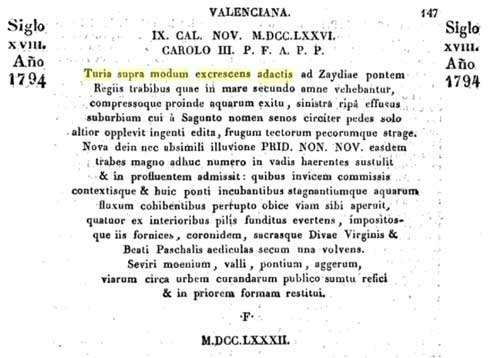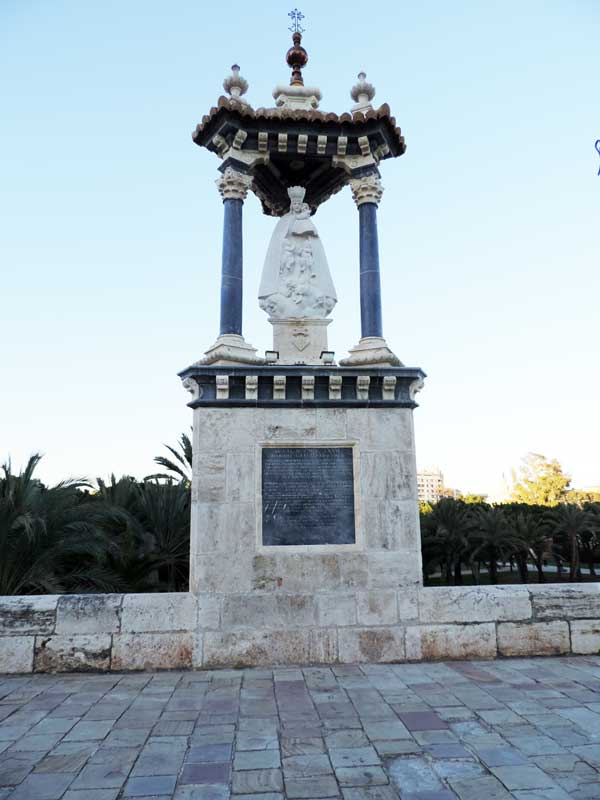Puente del Mar, Valencia (1782)
This Roman inscription, beneath the statue of Nuestra Señora de los Desamparados (Our Lady of the Abandoned), on the Puente Del Mar (Valencia) was probably written and/or engraved in 1782 by D. Fancisco Perezio Baierio (Pérez Bayer). It recalls the disastrous floods that befell the city of Valencia in October and November 1776 during the reign of King Charles III of Spain.

Image above: photograph of the text by G.Dijkman (Valencia, December 2016)
Latin
IX CAL NOV MDCCLXXVI, REGNANTE CAROLO III P(IUS) F(ELIX) A(UGUSTUS) P(ATER) P(ATRIAE)
TURIA SUPRA MODUM EXCRESCENS ADACTIS AD ZAIDIAE PONTEM REGIIS TRABIBUS QUAE IN MARE SECUNDO AMNE VEHEBANTUR COMPRESSOQUE PROINDE AQUARUM CURSU SINISTRA RIPA IT FUSUS SUBURBIUM CUI A SAGUNTO NOMEN SENOS CIRCITER PEDES SOLO ALTIOR IMPLEVIT INGENTI EDITA FRUGUM TECTORUM PECORUMQUE STRAGE
NOVA RURSUM STUPENDAQUE ALLUVIONE PRID(IE) NON(AS) NOV(EMBRIS) TRABES MAGNO ADHUC NUMERO IN VADIS HERENTES SUSTULIT ET IN PROFLUENTEM ADMISSIT, QUIBUS INUICEM COMMISSIS CONTEXTISQUE ET HUIC PONTI INCUBANTIBUS STAGNANIIUMQUE AQUARUM FLUXUM COHIBENTIBUS PERRUPTO OBICE VIAM SIBI APERUIT, QUATUOR EX INTERIQRIBUS PILIS FUNDITUS EVERTENS IMPOSITOSQUE FORNICES CORONIDEM SACRASQUE DIVAE VIRGINIS ET BEATI PASCHALIS AEDICUI AS SECUM UNA VOLVENS
SEVIRI MOENIUM VALLI PONTIUM AGGERUM VIARUM CIRCA URBEM CURANDARUM PUBLICO SUMTU REFICI ET IN PRIOREM FORMAM RESTITUI
F ANN MD XXXII
Translations
Translation proved hazardous, as the text is rather a mystifying experience. Dr. Rudi Frank, renowned senior Dutch classicist, kindly assisted with the translation. He comments that Bayer, the author and/or engraver of this text, was a bit of a 'classical Latin maniac', and has deliberately rendered the text as incomprehensible as possible, e.g. by the abundant use of participium constructs. He adds that Pope Paschalis was never officially canonised, hence 'beati Paschalis'. Below English translation is based on the Dutch translation.
English
On the 24th of October 1776, during the reign of [Emperor] Charles III, Pius Felix Augustus, Father of the Nation, the Turia River has swollen to an extraordinary degree caused by a supply of royal tree trunks in the direction of the Zaidi Bridge, transported downstream to the sea. As the river course was consequently narrowed, it overflowed in an ever widening fashion, the left bank of the suburban areas, named after Saguntum, and has flooded it six foot higher than the ground, causing an enormous devastation to crops, houses and cattle.
On the eve of 5th of November, [the river] lifted the tree trunks, hitherto stuck in superficial areas, in a new, big and astounding flood, and discharged them in the ever flowing river; while these trunks had been trapped and tied together, lying against the bridge, containing the swelling of the stagnant waters, [the river] made way by breaking the blocks and completely destroying the four inner supporting arches, including the arches on top, the crown with the holy chapels of the divine virgin and beatified Paschalis, taken down wallowing in the river.
The college of six men charged with the maintenance of the city wall, bridges, dams and the roads encircling the city ordered the execution of repairs, and to restore everything in the original state, at the expense of the state.
F(rancisco Perezio Baierio = Pérez Bayer) in the year 1782
Nederlands
Op 24 oktober 1776, gedurende de heerschappij van [Keizer] Karel III, Pius Felix Augustus, Vader des Vaderlands, is de Turia-rivier buitenmate gewassen door de aanvoer naar de Zaidi-brug van koninklijke boomstammen, die stroomafwaarts werden getransporteerd naar zee, en doordat de bedding/loop van de wateren daardoor vernauwd is, liep deze zich verbredend over de linkeroever van de voorsteden, genoemd naar Saguntum en heeft die zes voet hoger dan de grond overstroomd terwijl een ontzettende verwoesting van gewassen en van huizen en vee is veroorzaakt.
Op de dag voor de 5e november hief [de rivier] door een nieuwe grote en verbijsterende overstroming boomstammen, tot dan toe in groten getal vastzittend in ondiepten op en loosde ze in de voortstromende rivier en terwijl deze met elkaar aaneengevoegd en samengebonden waren en tegen deze brug aanlagen en de vloed van stilstaand water tegenhielden, baande hij [de rivier] een weg voor zich door de versperring te doorbreken door de vier binnenste steunbeuken totaal te verwoesten en de erop gelegen bogen en de kroon met de heilige kapelletjes van de goddelijke maagd en de zalige Paschalis met zich mee te wentelen.
Het college van zesmannen met de zorg voor de stadsmuur, de wal, de bruggen, de dammen, en de wegen die rond de stad lopen, [heeft gelast] reparaties te verrichten en alles in de vroegere vorm te herstellen op staatskosten.
F(rancisco Perezio Baierio = Pérez Bayer) In het jaar 1782
Español (jdiezarnal.com)
En 24 de octubre de 1776, reinando Carlos III Pio, Feliz, Augusto, padre de la patria, tuvo el Turia una inmensa avenida, y aglomerándose hacia el puente de la Zaidia los grandes maderos que arrastraba el río, obstruyeron el paso de las aguas, las que se desbordaron por la orilla izquierda, inundando el próximo arrabal llamado de Sagunto, y subiendo el agua mas de seis pies, con grande perdida de cosechas, casas y reses.
No fue menor la avenida que ocurrió luego en 4 de noviembre, arrastrando el agua los mismos maderos que dejara poco antes en las calles, encrucijadas y caminos, los cuales fuertemente trabados entre si, y hacinados sobre este puente del mar impidieron el libre curso de las aguas que, estancadas y creciendo desmedidamente, abriéndose paso a través del mismo, arrastrando en su furiosa corriente e inmensa balamba cuatro pilares con los arcos, cornisa, templetes, chapiteles, sagradas estatuas de Nuestra Señora y San Pascual Bailón y demás que colocados sobre el puente estaba.
Los seis obreros de la fábrica muros, valladares, puentes, calzadas y caminos de la ciudad procuraron que a expensas públicas se reedificase y se restituyese a su primitiva forma. Habiéndolo terminado felizmente en el año 1782
Image above: the inscription beneath the statue of Nuestra Señora de los Desamparados, sculptured by Don Fransico Sanchis (photograph G.Dijkman, December 2016)
Biblioteca Valenciana: second version
A reference to this inscription is found in: 'Bibiloteca Valenciana de los Esnìtones que florecieron hasta nuestos días y de los que aún viven. Con adiciones y enmiendas á la de D. Vicente Ximeno’, Por D. Justo Pastor Fustèr, Socio de Mérito de la Real Sociedad Económica de Valencia y su Reino; Tomo Secundo; Valencia, Imprenta y Libreria de Idelfonso Mompiè, año 1830.
In this book, the Latin text is given, but no translation. However, there is a short desciption of its historical context in Spanish.
"(p.146) En este tiempo suciedieron las dos furiosas y grandes avenidas del Rio Turia: la primera en 21 Octubre 1776, y la segunda en la tarde de 4 de Noviembre del mismo año, y a causa de estar atravesados en los arcos del del Puente llamado del Mar (que aunque muy sólido, por ser este, como igualmente los otros cuatro construidos, sobre el Túria de piedra de silleria) muchos maderos que llevaba la corriente por cuenta del Gobierno, con direccion al mar, para el arsenal de Cartagena; en la madrugada del día 5 rompió, y llevó los tres arcos del medio, y mitad de uno de cada lado del dicho Puente, causando grandes daños en los arrabales de la Ciudad, especialmente en el de la calle de Murviedro."
"Reedificado por cuenta de la Junta de Muros y Valladares, se colocó en el nuevo casilicio y en el mismo lugar que anteriormente ocupaba una gran cruz de piedra, la imagen de nuestra Señora de los Desamparados, labrada por Don Fransico Sanchis, discípulo del célebre escultor D. Francisco Vergara, é invitado por la referida corporación, compuso el Señor Bayer la inscripcion, que grabada en piedra negra se colocó bajo la expresada Imagen, y hemos copiado del original que escribió dicho Señor, y es la sigiente (...)"

Image above: page 147 of 'Biblioteca Valenciana', showing that this version of the inscription differs slightly from picture above.
Latin text according to Biblioteca Valenciana (differences highlighted in bold)
IX CAL NOV MDCCLXXVI, REGNANTE CAROLO III P(HILIPPI) F(ILIO) A(SBURGO) P(ATER) P(ATRIAE)
TURIA SUPRA MODUM EXCRESCENS ADACTIS AD ZAYDIAE PONTEM REGIIS TRABIBUS QUAE IN MARE SECUNDO AMNE VEHEBANTUR, COMPRESSOQUE PROINDE AQUARUM EXITU, SINISTRA RIPA EFFFUSUS SUBURBIUM CUI A SAGUNTO NOMEN SENOS CIRCITER PEDES SOLO ALTIOR OPPLEVIT INGENTI EDITA, FRUGUM TECTORUM PECORUMQUE STRAGE.
NOVA DEIN NEC ABSIMILI ILLUVIONE PRID(IE) NON(AS) NOV(EMBRIS) EASDEM TRABES MAGNO ADHUC NUMERO IN VADIS HAERENTES SUSTULIT ET IN PROFLUENTEM ADMISSIT: QUIBUS INVICEM COMMISSIS CONTEXTISQUE ET HUIC PONTI INCUBANTIBUS STAGNANTIUMQUE AQUARUM FLUXUM COHIBENTIBUS PERRUPTO OBICE VIAM SIBI APERUIT, QUATUOR EX INTERIQRIBUS PILIS FUNDITUS EVERTENS, IMPOSITOSQUE IIS FORNICES, CORONIDEM, SACRASQUE DIVAE VIRGINIS ET BEATI PASCHALIS AEDICULAS SECUM UNA VOLVENS.
SEVIRI MOENIUM, VALLI, PONTIUM, AGGERUM, VIARUM CIRCA URBEM CURANDARUM PUBLICO SUMTU REFICI ET IN PRIOREM FORMAM RESTITUI
-F-
MDCCLXXXII
Mysteries
The 'Biblioteca Valenciana' version seems to solve the mysterious original date at the end: MD XXXII (original) is replaced with MDCCLXXXII (1782). The Spanish text mentions Bayer as the maker of these inscriptions. It appears that this is D. Francisco Perezio Baierio (Pérez Bayer), an archdeacon and 'canonico' of the City of Valencia, but also a renowned humanist (according to a study in 1929, see sources below). Thus, the final 'F' would stand for 'Francisco'.
Charles III of Spain (1716-1788) was the son of Philip V of Spain (1683-1746), they both belonged to the House of Bourbon. He was given three 'honorary titles' (Pius, Felix Augustus) left untranslated in Dutch and English. The Spanish translation translates these titles as 'Pio, Feliz, Augusto'.
Source
- google search (TURIA SUPRA MODUM EXCRESCENS ADACTIS)
- photograph & translation into Dutch by G.Dijkman & Dr. Rudi Frank (Hellasroma Cursussen, Amstelveen; to be contacted by info at rfrank.nl), 2017
- Spanish translation: http://www.jdiezarnal.com (consulted June 2017)
- Francisco Pérez Bayer: http://roderic.uv.es/bitstream/handle/10550/58095/ANA1928090066-67.pdf?sequence=1&isAllowed=y


 design: Caro Dijkman -
design: Caro Dijkman -